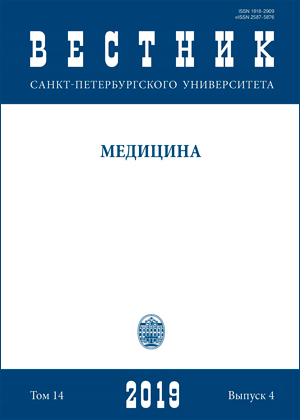Personalized prognosis of sarcoidosis based on the complex analysis of possible aetiological agents and mechanisms of immunopathogenesis
DOI:
https://doi.org/10.21638/spbu11.2019.417Abstract
The current concept of immunopathogenesis of sarcoidosis is based on an exaggerated immune response to a specific unidentified antigen. In recent years, the high Th17-cell plasticity has been shown to play an important role in the pathogenesis of sarcoidosis, along with contribution of Th1. In this study an analysis of Tfh subpopulation composition in peripheral blood of patients with chronic sarcoidosis debut was performed. Electron microscopic analysis of the microbiological component of bronchoalveolar lavage fluid was conducted to identify infectious agents, in order to determine their aetiological significance in patients in the early stages of sarcoidosis. The data obtained indicate a shift in the balance of Tfh cells towards cells with proinflammatory phenotype, which may indicate their active participation in the immunopathogenesis of sarcoidosis. Commensal bacteria representatives of the normal microbiota were observed in bronchoalveolar lavage fluid. Morphological properties of macrophages witnessed for the active manifestation of their phagocytic function.
Keywords:
sarcoidosis, cytokines, chemokines, immunopathogenesis, granuloma, electron microscopy
Downloads
References
Ilkovich M.M., Baranova O.P. Sarcoidosis of Respiratory System. In: Interstitial and Orphan Lung Diseases. GEOTAR-MEDIA, M. 2016, 163-235. (in Russian)
Schupp J.C., Tchaptchet S. et al. Immune response to Propionibacterium acnes in patients with sarcoidosis – in vivo and in vitro. BMC Pulm Med. 2015; 15: 75.
Zimmermann A., Knecht H., et al. Atopobium and Fusobacterium as novel candidates for sarcoidosis-associated microbiota. European Respiratory Journal 2017 50: 1600746.
Suchankova M., Paulovicova E. et al. Increased Antifungal Antibodies in Bronchoalveolar Lavage Fluid and Serum in Pulmonary Sarcoidosis. Scandinavian Journal of Immunology 2015 81(4); 259–264.
Scher J.U., Joshua V. et al. The lung microbiota in early rheumatoid arthritis and autoimmunity. Microbiome 2016; 4:60.
Downloads
Published
How to Cite
Issue
Section
License
Articles of "Vestnik of Saint Petersburg University. Medicine" are open access distributed under the terms of the License Agreement with Saint Petersburg State University, which permits to the authors unrestricted distribution and self-archiving free of charge.




